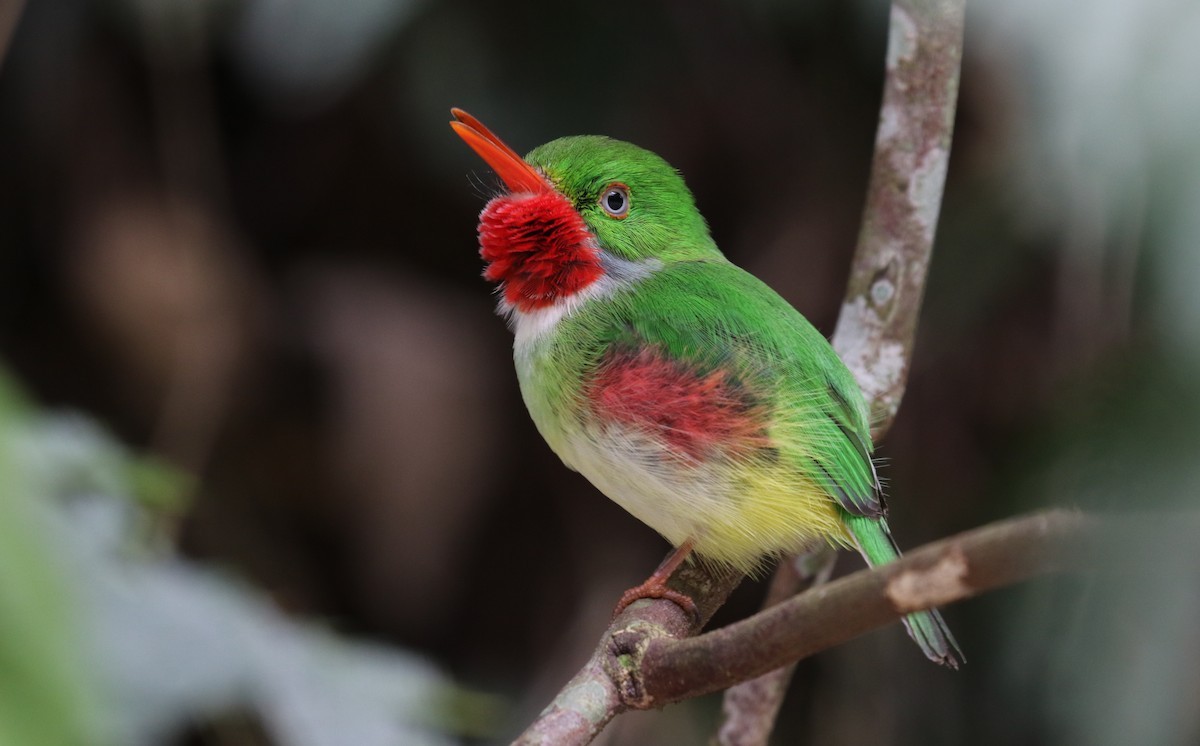Jamaican Tody
A species of Todies Scientific name : Todus todus Genus : Todies
Jamaican Tody, A species of Todies
Botanical name: Todus todus
Genus: Todies
Content
Description General Info
 Photo By Michael Woodruff
Photo By Michael Woodruff Description
The Jamaican tody is a small, chunky bird that averages about 9 cm (or 4.25”) in size. The wing size for all tody species ranges between 42.8mm and 50.3mm. The Jamaican tody's wing size is right in the middle of these sizes, about 46mm, compared to the Cuban and Puerto Rican todies which tend to have smaller wings and the broad-billed tody which has the largest. The wing size of the Jamaican tody correlates with their average flight distance which is about 1.5m, and their maximum flight distance which is 26m. The average weight of the Jamaican tody is around 6.4 grams. They have a bright green head, red throat and a long, broad and flat red bill. They look very similar to the Puerto Rican tody (Todus mexicanus) but have a whitish breast that is blended with green, becoming even slightly yellow on the abdomen and under tail-coverts. The Jamaican tody also has blue-gray subauricular feathers. Their legs and feet are reddish brown. Todies are generally a sexually monomorphic genus. However, some tody species have different eye colors between males and females, but in the Jamaican tody, this iris color is unpredictable. Jamacain todies are very quiet birds during nonbreeding months but can be heard more frequently during the spring and summer. The vocalizations of the Jamaican tody are predominately a loud beep sound and a throat-rattle. (see external link below) The loud beep is a nasal sounding note that is similar in length to the loud beep of the Puerto Rican tody. The throat-rattling is a rapid, harsh-sounding noise that is made with an open bill of about 3mm and is produced often in territorial defense. 
Size
11 cm
Nest Placement
Cavity
Feeding Habits
Jamaican Tody consumes primarily insects and larvae, supplementing its diet with small fruits. It forages by pouncing from perches, showcasing unique hunting agility. Jamaican Tody prefers prey from foliage and under bark, illustrating dietary specialization.
Habitat
Jamaican Tody predominates in a variety of forested habitats ranging from wet to dry forests and is particularly abundant in wooded hills and mountains. This bird favours primary and secondary woodlands, including types such as mangroves and dry lowland forests, with an affinity for areas with a misty climate at mid-elevations. Although jamaican Tody is adaptable, it tends to avoid pine plantations and is seldom found above 1500 meters in high-elevation regions.
Dite type
Insectivorous
General Info
Feeding Habits
Bird food type
Behavior
Todies can be found generally performing two bathing techniques, bathing in flight after a dive and bathing is wet plant leaves or in light rain. They also perform bill-wiping where they will clean both sides of their beak, from base to tip, especially after eating or preening and fluffing their feathers. To fluff their head feathers, they will share their head back and forth in a fast, jerky movement. Todies also preen their feathers with their flat bills and this mainly occurs in their breast and wing areas on their body. 
Distribution Area
The Jamaican tody (Todus todus) is endemic to Jamaica. They are found all around the island and can be seen near the semi-arid coast or in the humid mountains. They generally travel in pairs and can be found most commonly in forested areas, occurring in second-growth, untouched habitats. These are the mesic limestone forests, arid limestone forests, montane forest, shaded coffee plantations and even in the mangroves. The Jamaican tody is most visible during the spring and summer months, and are much more silent and easy to find during the fall and winter. 
Species Status
According to the IUCN Red List of Threatened Species, the Jamaican tody is classified as least concern. The justification for this classification is that although they live in a small range, they still meet the size criterion and do not have greater than 30% decrease in population size over 10 years. 

 Photo By Michael Woodruff
Photo By Michael Woodruff